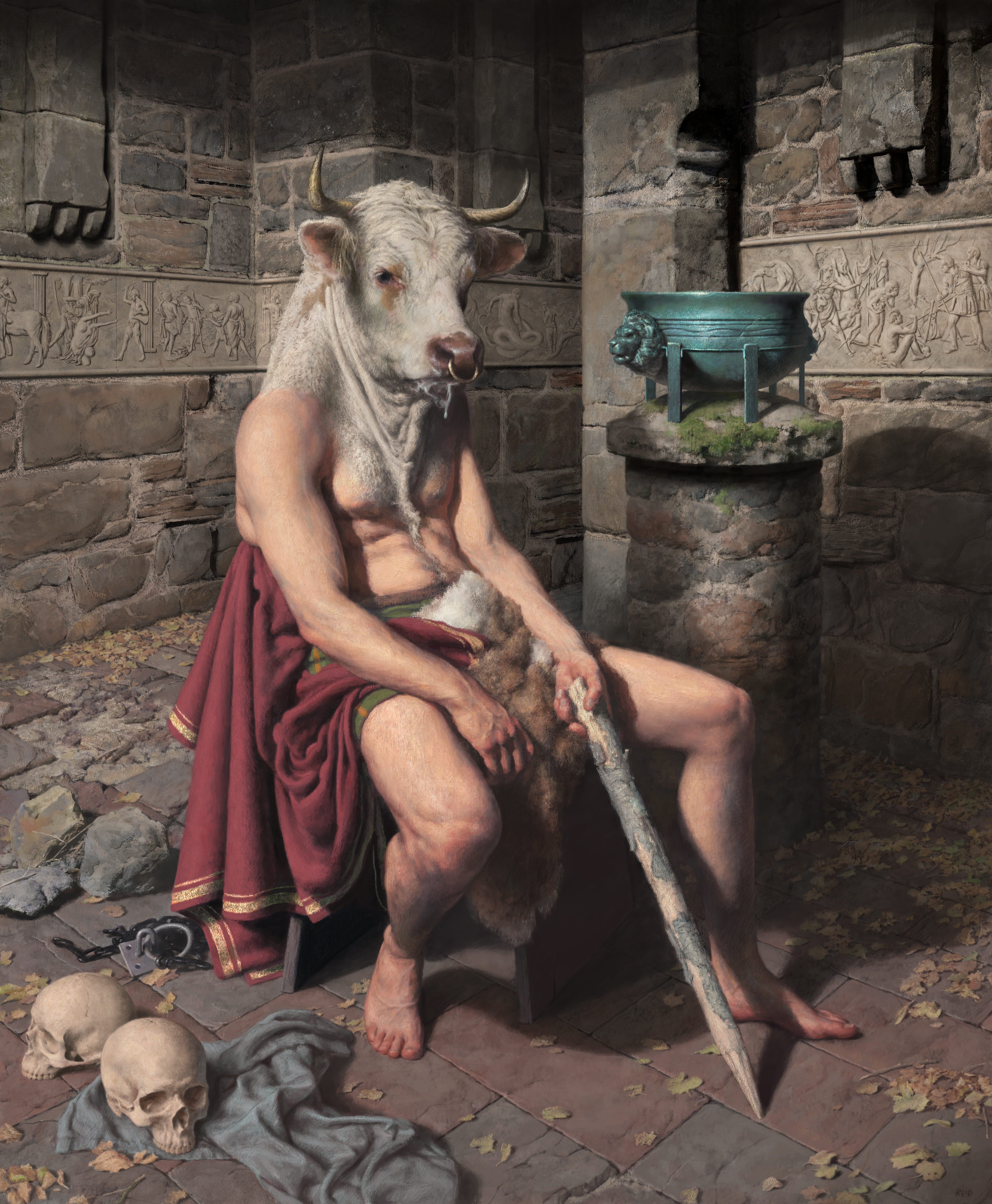IMN #21 — Paul Reid

It's Monday Night #21
Tonight, let’s share thoughts about @Minotaur_Man: he demonstrates the unexpected power of anachronism in digital painting through an austere, cold & tragic iconography.
Out of context but relevant.
The first thing that stands out in @Minotaur_Man's painting is that it does not pretend to be our contemporary at all. It is a return to ancient Greek mythologies that owes as much to neo-classical history painting as to 1960s fantasy cinema.
At first sight, there's something unfashionable about @Minotaur_Man's style.
First, the subject: creatures and heroes - mostly male - from Greek mythology.
The character is most often alone, in an easily recognizable setting: the story that the legend tells is translated into symbols (architecture, weapons, clothing, etc.).
More rarely, another character is present in the scene, and in this case the painting represents an action narrated by one of the ancient poets (Homer, Hesiod, Virgil or Ovid).
In one, there is for example Odysseus approaching discreetly the house of Circe and discovering with horror one of his sailors transformed into a pig by the witch. In the other, it is Theseus who is about to kill the Minotaur in the labyrinth built by Daedalus in Crete.
Then, the pictorial language. @Minotaur_Man's style is pure, clean and smooth, the skin tone of the naked bodies is sober - like the ancient marbles. Tones are pale, touches are imperceptible.
There are few expressive effects, even the faces - which are often monstrous or inhuman. The neo-classicism of @Minotaur_Man is marked by the refinement of the contours, a discreet modeling and a defiance towards color.
The bodies are athletic and tended towards a certain form of perfection and at the same time their sensuality is attenuated, veiled. They have a frozen, sculptural attitude, even when an action is taking place.
In the same way, landscapes are represented with marked geometrical perspectives, clear facture and sharp planes.
These different elements converge in a kind of untimely formalism.
This is what gives @Minotaur_Man's painting its unfashionable, pseudo-academic character, without equivalent in the NFT space.
But you have to take a closer look at his work.
In neo-classical art, mythological themes generally have the function of educating or edifying: they allow the exaltation of moral or heroic virtues: wisdom, courage, intelligence, etc.
Let us remember the ancient definition of the hero. What makes the hero is not only his noble or even divine genealogy, it is his excellence and superiority on this or that plane of existence - war, friendship, religion, etc.
But heroes are so far above other humans that they can sometimes believe they are - and sometimes become - equal to the gods. The Greeks had a name for this: the hubris, an excessive pride or self-confidence.
What is remarkable about @Minotaur_Man's painting is that the heroes are neither models of virtue nor examples of excess. On the contrary, it shows inactive heroes in abandoned landscapes.
They are fallen heroes, without aura, without prestige.
From one painting to another, there is an impression of expectation, boredom and even a slightly melancholic sadness.
On the one hand, because the hybrid figures - half-animal half-human - are subjected to an anthropomorphism: the gaze (frontal or vague), the posture suggest a profoundly human distress.
On the other hand, he @Minotaur_Man shows heroes in peril, who are distinguished by their extreme vulnerability, agony or upcoming death. Cracked characters.
What interests @Minotaur_Man is precisely the moment of decline, this floating second the hero becomes aware of his destiny and wavers, doubts. In this sense, his painting is "post-dramatic" - it does not represent an action or an event, but a void or an idleness.
Nevertheless, let me point out that the framing is less pictorial than cinematographic, the use of a low angle view, an asymmetrical composition or the close-up for example.
From a formal point of view, the field of perception implies that the image should be in motion and this makes its stillness all the more disturbing.
I am thinking in particular of the film Jason and the Argonauts directed by Don Chaffey (1963).
Remember the way Ray Harryhausen animates evil monsters, he was one of the first to use the stop motion technique.
Of course, Harryhausen's work seems quite rudimentary today. It makes you laugh more than it scares you. Obviously.
But what is more interesting is that he confers, through his relatively clumsy bricolage, a form of fragility and humanity to the creatures he animates.
I find this fragility in the characters of @Minotaur_Man who are as if crushed under the weight of their own mass - as if they no longer know what action to take, what to do with their bodies.
This is made all the more palpable by the fact that we, as spectators, are a little too close to the scene, so that we are looking at it with a prying eye. We are put in the position of a mobile observer, moving backwards and forwards.
In this sense, he deconstructs the relationship to the space of pictorial representation. We are no longer faced with a structured and balanced composition and placed at an optimal distance from the action.
On the contrary, a painting is only a shot among others, without any privilege.
While it seems to be illustrated by an old-fashioned classicism, @Minotaur_Man destitutes both the immemorial figure of the hero & the way it has been represented in the history of Western painting.
He revisits the neo-classical canons by confronting them with an outdated cinematographic tradition that is still alive in our aesthetic unconscious.